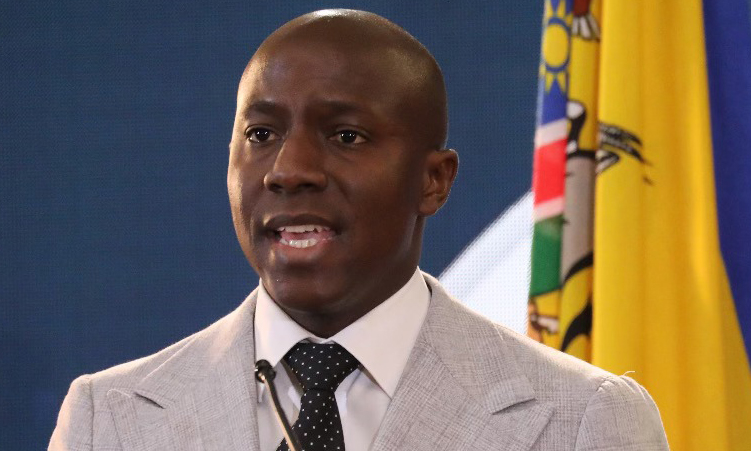… No answers on why Mnyupe travelled with president for private US medical treatment
Political commentators are asking why Bank of Namibia (BoN) governor Johannes !Gawaxab requested the late president Hage Geingob to approve the appointment of new central bank board members on his sickbed.
The remarks have reignited the debate on whether there is a need to keep ailing heads of state from performing state duties.
These questions arise at a time when The Namibian has been seeking clarification from State House on why green hydrogen commissioner and presidential economic adviser James Mnyupe accompanied Geingob on his medical treatment trip to the United States last month.
The Presidency announced on 19 January that Geingob was diagnosed with cancer, but that he would still carry out his official duties.
Speaking at Geingob’s memorial service in Windhoek on Wednesday, !Gawaxab praised his dedication to public service as he signed off on the appointment of new members to the BoN board weeks before his death while in poor health.
“The president was sick, and two weeks ago we needed to appoint board members of the Bank of Namibia. On his sickbed he realised what this nation requires ..
.
“We sent that letter, we spoke, and he signed the letters of appointment of the new board members,” !Gawaxab said.
Lawyer Eliaser Nekwaya, a former employee of the central bank, Meshack Tjirongo, and manager of information systems and technology at a Namibian uranium mine Pieter Kruger were appointed as non-executive members of the bank’s board of directors, while Ehrenfried Meroro was reappointed, effective from 1 February, for a period of five years.
Central bank spokesperson Naufiku Hamunime yesterday said while the approval letter was signed by Geingob on 17 January, two days before the Presidency publicly announced Geingob’s cancer diagnosis, the process of recommending candidates for board appointments to the president began last year with the announcement of vacancies.
“A selection committee interviewed the potential candidates and presented a list to the minister of finance, who then made recommendations to the president. On 17 January, the appointment letters for the relevant board members were signed,” he said.
Hamunime said !Gawaxab’s comment at the memorial service aimed to highlight Geingob’s prioritisation of national duties during this period.

LAST MEETING
The day before the Ministry of Education, Arts, and Culture announced the country’s grade 11 and 12 results, a ministerial delegation led by minister Anna Nghipondoka and executive director Sanet Steenkamp met with Geingob.
Little did they know this would be the last meeting with him.
Steenkamp, who received news of the president’s death while at Lüderitz, this week said: “We met his excellency on 9 January at his private residence … We decided that because of the announcement around his health, we would keep the engagement short …
“They were 45 minutes packed with intensity, but also very light moments. He came into the room. He admitted to us that he was waiting for his doctors to give him news that day, and that he expected that not to be good news,” she said.
QUESTION MARKS
Political scientist Rui Tyitende says Geingob was medically unfit to fulfil his official duties at the time.
“When someone is in hospital, and in the state that Geingob was in, they are clearly not of sound mind. Why did !Gawaxab deem it urgent that the president sign off the appointment of the board members while in a critical state?” he asks.
Tyitende questions the urgency of the matter.
On 24 January, it was announced that Geingob would travel to the United States for novel cancer treatment.
Political commentator Henning Melber says the revelation that Geingob was performing official duties during his illness raises doubts about his ability to carry out these tasks effectively.
“It casts unfortunate and regrettable doubt on anything implemented now based on Geingob’s signatures during his last days, when he clearly did not have his normal strength and abilities any more,” Melber says.

According to Namibian Sun, data sourced from Flightradar24, a website for tracking aircraft, suggests Geingob travelled to the US through Algeria aboard a Gulfstream 5 aircraft, rather than using the presidential Falcon assigned to him.
The aircraft is said to have originated from Qatar, yet no specifics were provided regarding the party who arranged its use nor their connection to Geingob.
The Namibian understands that a top Qatari government official funded the trip, including supplying the aircraft to and from the US.
THE ADVISER
The Namibian has also learnt that James Mnyupe, Geingob’s economic adviser and green hydrogen commissioner, accompanied him to the US last month.
Tyitende also raises questions on the capacity in which Mnyupe accompanied Geingob to Los Angeles.
“What was James Mnyupe doing on a Qatari private jet?” political commentator Joseph Diescho also asks.
Despite multiple attempts to reach them, neither Mnyupe, nor presidential spokesperson Alfredo Hengari responded to queries sent by The Namibian.
Geingob returned from the US on 31 January and was hospitalised at Lady Pohamba Private Hospital in Windhoek until his death on 4 February.
During his hospitalisation, current president Nangolo Mbumba, who served as vice president at the time, took over Geingob’s tasks.
– Additional reporting by Kelvin Chiringa
Stay informed with The Namibian – your source for credible journalism. Get in-depth reporting and opinions for
only N$85 a month. Invest in journalism, invest in democracy –
Subscribe Now!






